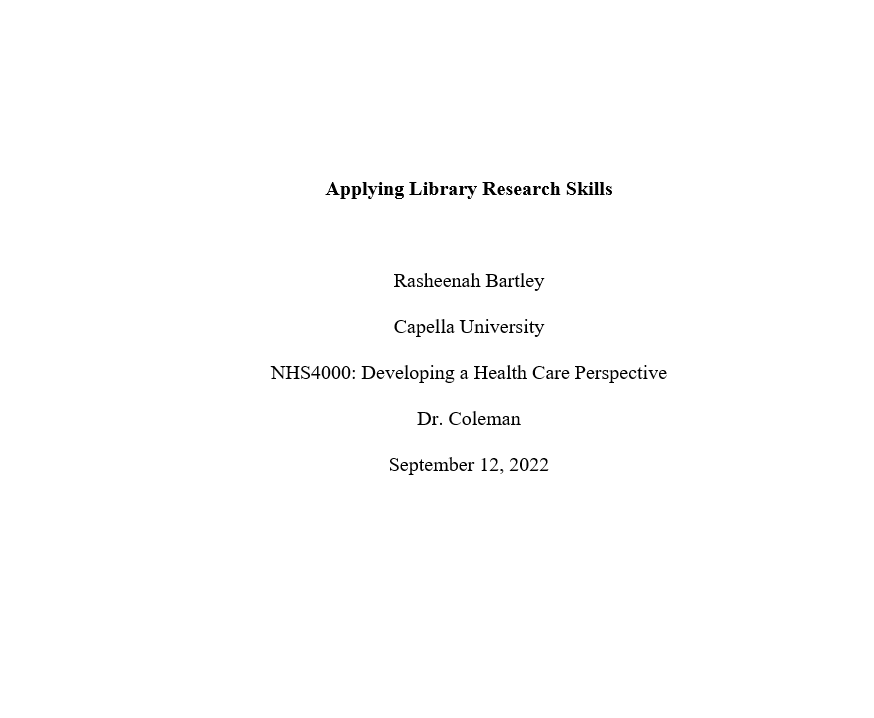Capella University
NHS4000: Developing a Health Care Perspective
Dr. Coleman
September 12, 2022
Applying Library Research Skills
Mental health is a topic that is often surrounded by some level of stigma. In addition, there is a significant amount of mental health care disparity among African Americans, people of color, and minorities, as compared to other groups. For reasons that include lack of access, cultural perspectives, and lack of representation, these groups are less likely to receive mental health care at all or even of equal quality.
As an African American woman who has long suffered from mental illness, this topic is relatable on a personal and professional level. Being a nurse and recognizing and witnessing the disparities piques my interest further than just having experienced it for myself. Even though it may be true that no one person can change the health care disparities among groups, every little thing counts. I have not worked in a psychiatric setting, but in any health care setting, one can encounter mental health situations. There have been instances for me when an African American person experiencing a mental health situation has been more apt to be open or receptive to information and care because there is commonality. In any regard, any of the nursing staff would be equipped to handle this, as we all learn about cultural and economic differences among groups. Still, having these experiences helps me to recognize that the health care disparity in this area exists and allows me to be cognizant of how many elements can work together to close the gaps.
Identifying Academic Peer-Reviewed Journal Articles
Through Summons and Pubmed, two databases that carry articles from multiple sources, I was able to access peer reviewed and scholarly articles related to healthcare disparities among African Americans related to mental health. Through advanced searching, I was able to narrow my search to articles from the last five years and ensure that they were peer reviewed and scholarly. Combining a search with keywords such as “health disparities”, “racial”, “mental health”, and “equity”, I was able to access relevant and peer reviewed information.
Assessing Credibility and Relevance of Information Sources
By searching for articles that were scholarly, peer reviewed, and within the last five years, I was able to secure credible information. Furthermore, by checking the credentials of the authors, I was assured that the information acceptable among the health care community.
As it pertains to having relevant information, I made sure the articles had authoritative sources and accurate information. This was also seen through the use of factual information as opposed to uncited, opinion based information.
Annotated Bibliography
Alang, S. M. (2019). Mental health care among blacks in america: Confronting racism and constructing solutions. Health Services Research, 54(2), 346–355. https://doi.org/10.1111/1475-6773.13115
In this article, the authors explore reasons blacks do not receive mental health care they may need, factoring in racism, and possible solutions. For example, blacks are less likely to seek care and if they do, they receive a lower level of care. This article examines the topic from an individual level up to an organizational level. Through exploration of qualitative and quantitative data, the authors aim to explain why blacks have a higher rate of unmet need and how to reduce that. The article concludes that blacks should look to self-reflection and at an organizational level racism should be explored. Many elements play a role in both levels and must be confronted to implement better mental health care conditions for blacks.
Cook, B., Hou, S.-Y., Lee-Tauler, S., Progovac, A., Samson, F., & Sanchez, M. (2018). A review of mental health and mental health care disparities research: 2011-2014. Sage journals. https://doi.org/10.1177/1077558718780592
This article summarizes research related to the mental health differences and disparities among minority groups as compared to Whites, the root causes, and interventions for reduction of those disparities. Furthermore, the article mentions how blacks and Hispanics had an increase in mental health care disparities during the timeframe of the study. The authors used a set of criteria to categorize and sort the articles being researched. As a main criterion for the research, the articles reviewed were those funded by the National Institute of Mental Health (NIMH). Overall, the study concluded that the implementations being put forth by NIMH has widened the research into mental health care disparities, but the research needs to continue to determine significance and the effect to higher levels such as policy. I chose this article because it does give a positive outlook on the research and resolutions of disparities in mental health care. Still, it presents the issue and methods for improvement.
Dwanyen, L., Holtrop, K., & Parra‐Cardona, R. (2021). Reducing mental health disparities among racially and ethnically diverse populations: A review of couple and family intervention research methods (2010–2019). Journal of Marital and Family Therapy, 48(1), 346–365. https://doi.org/10.1111/jmft.12573
In this article, the basis of the study revolves around the presence of minority groups in research studies as it pertains to mental health. The finding was that in the sample of articles reviewed, only a quarter of those were based on predominantly minority and underserved groups. The authors specify that blacks see “disparities in mental health outcomes and treatment access”, based on a number of factors. It goes on to conclude that these studies are overall lacking in diversity and provides a call to action to reduce disparities in this category of mental health. One mention of achieving that is by using methodologies that are culturally and ethnically sensitive. This article was chosen because it uses information from many reliable sources to show the issue and provides a feasible way to begin the process of reduction of mental health care disparities. Throughout the article it can be seen why these inequalities exist among groups, how researchers exclude those groups, and solutions to close the gaps.
Friis-Healy, E. A., Nagy, G. A., & Kollins, S. H. (2021). It is time to react: Opportunities for digital mental health apps to reduce mental health disparities in racially and ethnically minoritized groups. JMIR Mental Health, 8(1), e25456. https://doi.org/10.2196/25456
This article focuses on using technology to reduce mental health care disparity in people of color, as it relates to the real-world events happening today. The authors use five key points to elaborate on their suggestions, which range from education to building trust. The point is to create something in real time and with room for adaptability. The article concludes that mental health care in a technological space has gained an increasing interest, especially during COVID. With that it is an optimal time to optimize accessibility to a digital format of mental health care while being cognizant of ethnic and cultural disparities. This article was chosen because it recognizes the growing mental healthcare disparity among people of color and offers many recommendations to clients and providers as a form of resolution.
Learnings from the Research
I was able to see layers of research through the articles I chose due to the research analyzing a plethora of other research. These articles supplemented my base knowledge by giving perspective into different levels of mental health care disparities in order to implement various methods to reduce inequalities. For example, while I knew that blacks and people of color not having representation in an immediate setting was an issue, I hadn’t considered that there was a lack thereof in research as well. This annotated bibliography will allow me to be able to better choose articles that have depth and bring more to a paper about the mental health care disparities.
References
Alang, S. M. (2019). Mental health care among blacks in america: Confronting racism and constructing solutions. Health Services Research, 54(2), 346–355. https://doi.org/10.1111/1475-6773.13115
Cook, B., Hou, S.-Y., Lee-Tauler, S., Progovac, A., Samson, F., & Sanchez, M. (2018). A review of mental health and mental health care disparities research: 2011-2014. Sage journals. https://doi.org/10.1177/1077558718780592
Dwanyen, L., Holtrop, K., & Parra‐Cardona, R. (2021). Reducing mental health disparities among racially and ethnically diverse populations: A review of couple and family intervention research methods (2010–2019). Journal of Marital and Family Therapy, 48(1), 346–365. https://doi.org/10.1111/jmft.12573
Friis-Healy, E. A., Nagy, G. A., & Kollins, S. H. (2021). It is time to react: Opportunities for digital mental health apps to reduce mental health disparities in racially and ethnically minoritized groups. JMIR Mental Health, 8(1), e25456. https://doi.org/10.2196/25456

